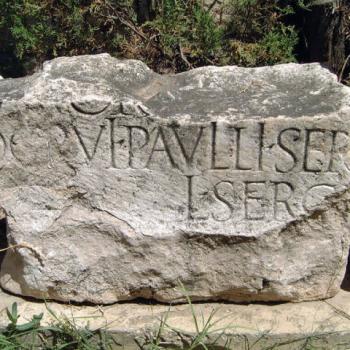 L.T. Johnson, Among the Gentiles: Greco-Roman Religion and Christianity, (Yale/Anchor, 2009), 480 pages.
L.T. Johnson, Among the Gentiles: Greco-Roman Religion and Christianity, (Yale/Anchor, 2009), 480 pages.
There are books which catch a rising tide of interest and scholarship in a subject and become seminal studies. There are books which go against the tide of general scholarly opinion, and sometimes they survive because of their excellence. And then there are books which float along calmly downstream and people recognize them for what they are, not timely tomes or decent dissents but something here today and gone tomorrow. Luke Johnson is, as Wayne Meeks has dubbed him, a contrarian. He likes to play the role of the loyal opposition to some of the sacred theories and ideas in the world of Biblical studies. While he may be a contrarian, he is not a curmudgeon, in fact he is well respected right across the guild of Biblical scholars, and rightly so. He is a scholar’s scholars and at the same time a really nice person. It’s hard to disagree with someone like Luke when he is so congenial in his way of being disagreeable. I have loved reading many of his books, and have been helped by numerous of his Biblical commentaries. This review however must tackle his latest footnote-laden monograph, and give it a thorough once over. It deserves it, not least because it won the $100,000 Grawmyer Prize awarded in Louisville to a top book in the field.
Let us start by mentioning some of the things that are missing in this study, that should be present. If one is going to tackle the subject of whether Christianity could be labeled a ‘religio’ in the ancient and Greco-Roman sense, and at what juncture one could actually call it such, one would have thought that attention would have to have been paid to the many many articles on the social history of the Greco-Roman world and early Christianity written by Edwin Judge, now conveniently collected into three volumes (two are out, and one is forthcoming— see the volume my old mentor David Scholer edited Social Distinctives of the Christians in the First Century (2007), and the gigantic collections of essays being published by J.C.B. Mohr). Johnson’s study is vast, one third of the close to five hundred pages are footnotes, there is extensive documentation—- and not a single reference to, or engagement with the work of Judge, or for that matter any of his disciples, such as Bruce Winter or Peter Marshall or Robert Banks, to mention but three. This is not merely an oversight, this is a huge lacunae in such a study.
But that is not all. Also M.I.A. is any engagement with the detailed work on early Jewish Christianity in the first four centuries of the Christian era by Richard Bauckham. Likewise, he is nowhere to be found in even the bibliography which go on for for well over a hundred pages. Why is this important? Because Bauckham has demonstrated at considerable length that Jewish Christianity continued to be an influential force in Christianity beyond the canonical era, and that we neglect that history at our peril. And the result of such neglect is not hard to find in this study. We could start with the fact that Johnson thinks only Hebrews and James are canonical books written largely for Jewish Christians. Really? What about Matthew or Jude or 1 John or even possibly 1 Peter. The canon has in fact more volumes written primarily for Jewish Christians than Johnson is prepared to allow.
Though Johnson admits that the structure of the earliest Christian communities are indebted to the synagogue structures, and that the church continued to use the LXX as its sole Scriptures for a very long time, he wants to argue that in fact Christianity, almost from the first developed as a Greco-Roman religion, on par and in many ways like pagan religions in terms of its religiosity or religious sensibility as he calls it. Now there is a strong case to be made for a good deal of what Johnson wants to assert, but not at the expense of recognizing the ongoing indebtedness of Christianity to not very Hellenized Judaism and its Holy Book. Take for example Johnson’s argument that the eventual structure of Christianity involving as it did priests, temples/basilicas, and sacrifices owed most to the already extant Greco-Roman religious structures. Johnson is of course not the first to argue such a case. We see this kind of case in the works of one of Johnson’s Yale mentors, Ramsay MacMullen (see his recent book The Second Church and its review in my blog archives at Beliefnet).
The problem with this argument is that it doesn’t give sufficient credit to the degree to which the OT institutions, involving priests, temples, sacrifices, holy days and the like influenced the thinking of people ranging from Clement of Rome to Augustine. One could certainly argue that OT exegesis and hermeneutics by Christian thinkers of the first four centuries which turned Sunday into a sabbath, and the Lord’s Supper into a sacrifice and the ministry into a priesthood, and church buildings into places where the sacrifice of the Mass was celebrated had as much to do with how Constantinian Christianity turned out as did the influence of Greco-Roman religion. In other words, the case Johnson makes in this book is lopsided, or even one-sided. What was needed was ‘both sides now’ to present us with a fair and balanced picture. Be that as it may, there is a very great deal to be said on behalf of this ground-breaking work, and we will begin to interact with his positive case in our next post.











